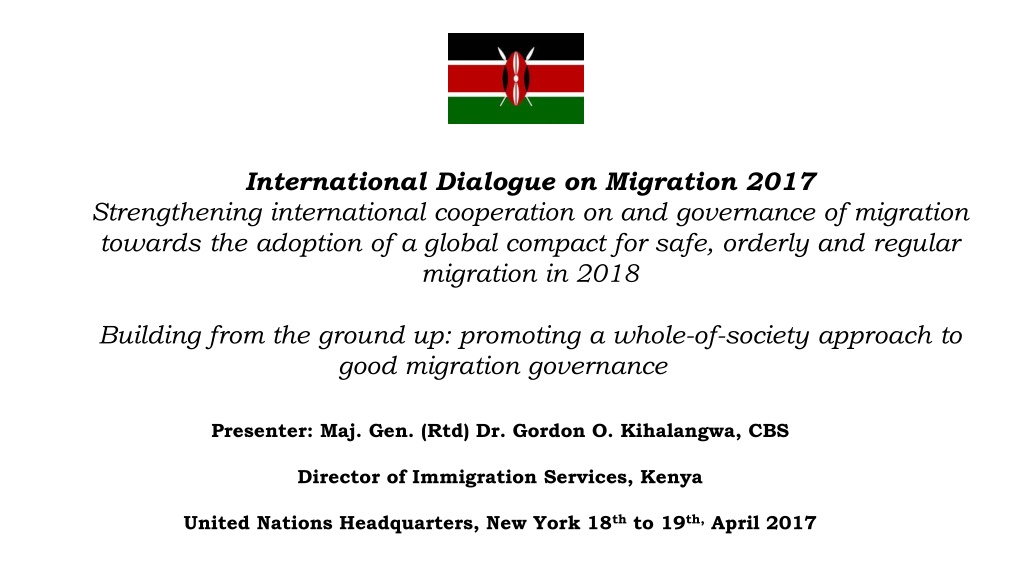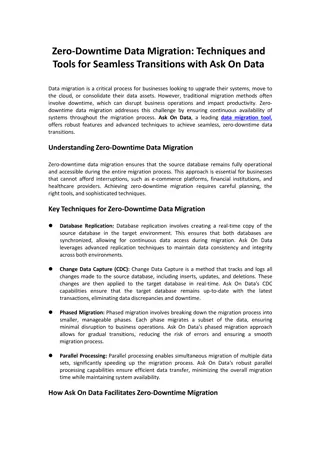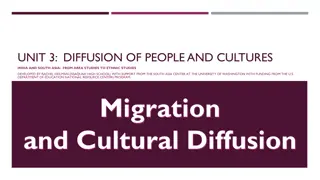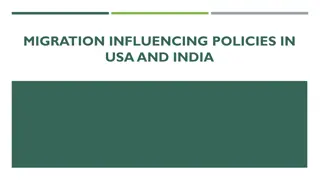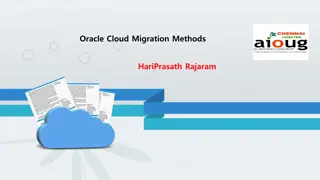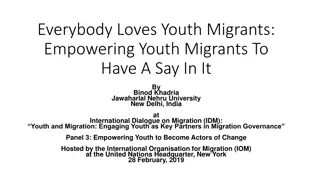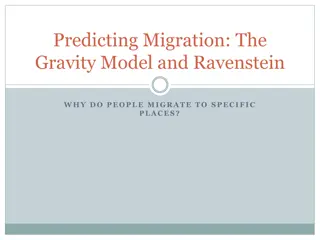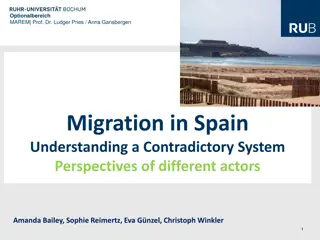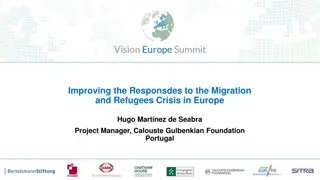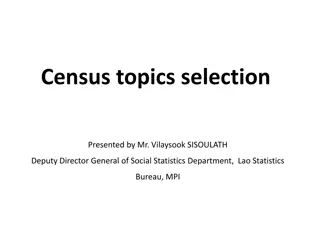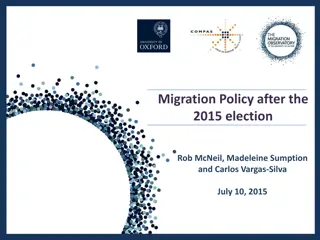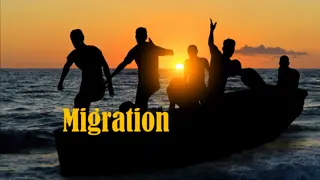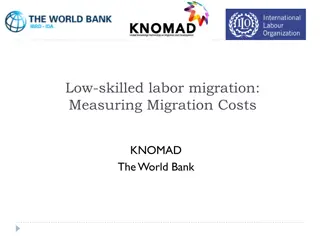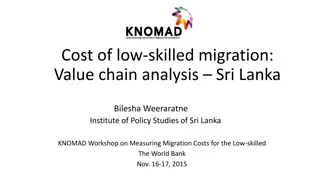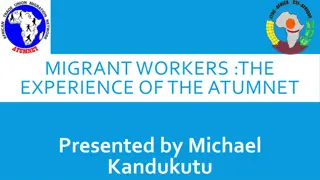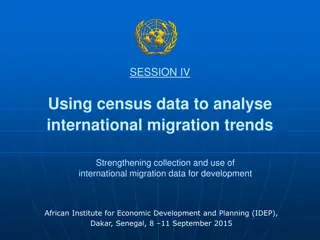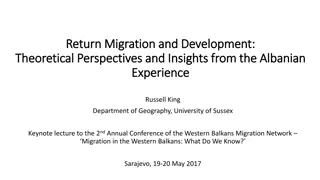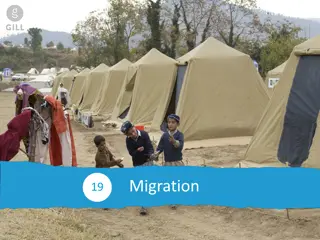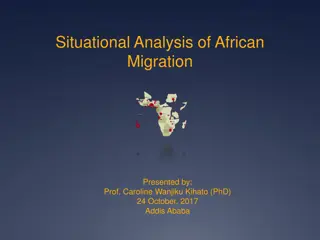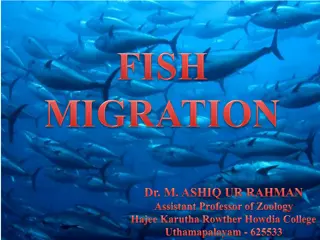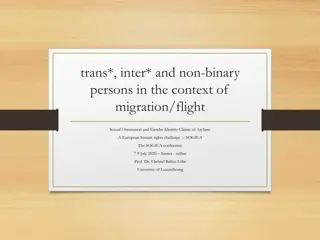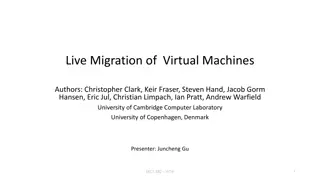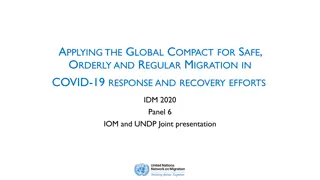Understanding Migration: Challenges and Perspectives
Migration is a global phenomenon that affects countries as either origin, transit, or destination points. The concept of fortified borders is crucial for national and global security, emphasizing the need for state regulation and control of migration. Various theories, such as global economic disparity and boundary conflicts, explain the causes of migration. Factors influencing migration include socio-political, economic, and ecological aspects, as well as communal violence worldwide.
- Migration Challenges
- Global Perspective
- Fortified Borders
- Economic Disparity
- Socio-political Factors
Download Presentation

Please find below an Image/Link to download the presentation.
The content on the website is provided AS IS for your information and personal use only. It may not be sold, licensed, or shared on other websites without obtaining consent from the author. Download presentation by click this link. If you encounter any issues during the download, it is possible that the publisher has removed the file from their server.
E N D
Presentation Transcript
International Dialogue on Migration 2017 Strengthening international cooperation on and governance of migration towards the adoption of a global compact for safe, orderly and regular migration in 2018 Building from the ground up: promoting a whole-of-society approach to good migration governance Presenter: Maj. Gen. (Rtd) Dr. Gordon O. Kihalangwa, CBS Director of Immigration Services, Kenya United Nations Headquarters, New York 18th to 19th, April 2017
Preamble Migration affects all countries either as countries of origin, transit or destination. This calls for national, regional and international cooperation Concept of fortified borders is critical to national and global security, hence the need for States to regulate and control migration Border-security missions are diverse and include efforts to prevent crime, maintain safety around borders, counterterrorism, illegal migration, illegal drug control, protect natural resources, and facilitate the legitimate movement of goods Border security is an integral part of national security. This includes among others; critical security infrastructure, significant fortification of border with optimum staff and equipment. This is regarded as the first line of defense in State security Kenya has adhered to international standards and fulfilment of migrants rights Formulated policy using evidence and includes all the government stakeholders on migration Engaged with partners to address migration
Theories of Migration Many theories have been advanced to explain causes of migration. In his International Migration: A Very Short Introduction, Koser (2007) notes that there are more international migrants today than ever before and their number is certain to increase for the foreseeable future. a)Global economic disparity. Majority of the world population live in the 175 developing countries while global income and wealth are concentrated in the 25 developed countries Martin P.L et al, (2006). This disparity has led to rising emigration from developing (source) to developed (destination) countries. b)Boundary conflicts. Adepoju s (1984) study revealed that demand for adjustment of boundaries arbitrarily drawn by colonial powers, which cut across economic homogeneous ethnic groups, to accommodate the socio-cultural realties have led to wars that produce asylum seekers who require refuge outside their countries. c)The Globalized media, advanced transportation and communication. The internet and globalized media beam the benefits of good life into the homes of world citizens daily. This reveals the hidden world on the move and full of opportunity, innovation, prosperity and creates the yearnings and desire to migrate and enjoy these values. d) The yearning for civil order and enfranchisement in the system which creates the overwhelming desire of ordinary men and women around the world to move where their civic and political, economic, social, and cultural rights are not only respected but also guaranteed. 3
Factors Influencing Migration Socio-political, economic and ecological Communal violence world-wide, often as a result of ethnic or religious intolerance Economic disparity between developing and developed economies Changes in the ecological environment leads to food and water insecurity in various parts of the globe
Horn of Africa Region: Migration through 3 different routes: 1) The Northern Route: Through Sudan, Libya, Egypt into Europe. 2) The Eastern Route: Gulf of Aden migration route: Djibouti, Northern Somalia, Yemen and eventually KSA and other Middle Eastern countries. 3) The Southern Route: Through Kenya, Tanzania, Mozambique, Zambia, Zimbabwe, Malawi to South Africa
Mixed Migration in Kenya Thirty five (35) Gazetted Entry and Exit Border Points A hub in the region and attracts a large flow of mixed migration Predominantly a country of destination and transit for smuggled migrants Hosts the largest refugee population of Somalis in the world - more than half a million, and a high number of Ethiopians and South Sudanese in the two camp complexes of Dadaab and Kakuma. 6
Promoting whole of society approach to migration governance in Kenya Before the introduction of the UN Sustainable goals, particularly the global compact on safe, orderly and regular migration, Kenya s approach to migration governance was inclined to whole of government rather than whole of society approach. This missed out on potential opportunities existing in the civil society and private sector that could be tapped to improve migration governance nationally Since the introduction of Global Compact on migration, the government of Kenya in collaboration with the International Organization for Migration (IOM) established a National Coordination Mechanism on Migration (NCM) to coordinate the activities of all relevant stakeholders in migration management and governance in the country. Since its inception in July 2016, the NCM has mapped key migration stakeholders among them non-state actors including the civil society, (NGOs, Faith Based Organizations (FBOs), academia and private institutions including schools that could add value to the global compact on migration. 7
Migration Governance in Kenya Functions of NCM Provide a platform for dialogue and collaboration for actors engaged in Migration; Address Migration issues in a coordinated and timely manner; Ensure policy coherence on Migration nationally; Serve as the focal point for regional and national undertakings on Migration. Advise policy makers on migration matters Develop and disseminate information materials on migration Identify knowledge gaps in Migration for research Ensure collection of quality and credible migration data Mobilize resources for migration management Department of Immigration Office of the Attorney General & Director of Public Prosecutions Ministry of Foreign Affairs National Coordination Mechanism (NCM) Kenyan National Commission on Human Rights Ministry of Labour, Social Security and Services Civil Society Organizations Ministry of Public Service, Youth and Gender Affairs & Private Sector
Regional Initiatives 1. Better Migration Management (BMM) aims at improving migration management in the region, and in particular to address the trafficking and smuggling of migrants within and from the Horn of Africa BMM further: Strengthen national governments in pursuing a whole of government approach to migration and border governance with the aim to effectively address trafficking in persons and smuggling of migrants, thus allowing for regional policy harmonization and cooperation in accordance with the relevant international conventions and standards as well as regional policy frameworks Builds capacity of all institutions and agencies responsible for migration and border management Improve the identification, assistance and protection for Victims of Trafficking (Of victims of trafficking (VoT)) and vulnerable migrants, especially women and children, in the Horn of Africa Raises awareness of alternative livelihood options including safe migration It is funded with 40 million from the European Union Emergency Trust Fund (EUTF) HoA-Window and co-funded with 6 million from the German Federal Ministry of Economic Cooperation and Development (BMZ) 2. Migration and Mobility Dialogue (MMD) Support Project seeks to maximise the development potential of migration and mobility within Africa and between Africa and the EU and to provide comprehensive responses to migration and mobility, in full respect of human rights. The project is funded by the European Union and implemented by the International Centre for Migration Policy Development (ICMPD) 3. The EU Regional Development and Protection Programme (RDDP) in the Horn of Africa, led by the Netherlands, has been set up to improve protection and enhance development prospects of refugees, IDPs and local communities, aiming to offer an alternative to risks of irregular migration. Ethiopia, Sudan and Kenya are key countries for the RDPP as they host large numbers of refugees from Eritrea, Somalia and South Sudan. In these countries, the RDPP aims to provide improved prospects for refugees as well as host communities with a view to allow beneficiaries to be able to provide for their own livelihood. 9
Partnerships and Cooperation on Regional Migration National Coordination Mechanism (NCM) EAC Common Market Protocol: The protocol provides for cooperation by the Partner States to achieve the free movement of goods, persons, labour, services and capital and to ensure the enjoyment of the rights of establishment and residents of the national within the Community The COMESA Protocols on the Free Movement of Persons, Labour, Services, Right of Establishment and Residence (The Free Movement Protocol) IGAD: Strategic priority number 2 of the IGAD Migration Action Plan (MAP 2015-2020) to build effective migration governance architecture in order to implement, monitor and evaluate the IGAD Regional Migration Policy Framework Northern Corridor Integrated Projects (Free movement of persons, Labour and Services) Joint Valletta Action Plan (JVAP) have had a positive impact on cooperation on migration and on jointly addressing migration between the EU and Africa Khartoum Process: Platform for political cooperation amongst the countries along the migration route between the Horn of Africa and Europe Abuja Treaty ratified by 49 countries: Member States of the AEC committed to the gradual removal, among Member States, of obstacles to the free movement of persons, goods, services and capital and the right of residence and establishment Banjul Charter: Ratified by 54 countries entered into force in October, 1986. Article 12 of the African Charter on Human and Peoples Rights makes specific references to aspects of free movement of persons Africa Union Commission: Draft Protocol on free movement of persons)
Partnerships and Cooperation on International Migration Global Forum on Migration and Development UN High-Level Dialogue on Migration and Development. AU. COMMIT: ( IOM, UNODC, UNHCR and RECs) UN Regional Consultative Mechanism: Social Welfare and Human Trafficking Sub Cluster (AUC, ECA, IOM, UNHCR, UNODC, UNICEF, EC, UN Women and OHCHR) Migration Working Group: AUC , EC, IOM, UNHCR, UNODC , LAS and ILO. 11
Policies that govern migration in Kenya Policies that govern migration in Kenya Year 2007 Policy Kenya Vision 2030 Content The country s development programme based around three pillars Economic, Social and Political. To be implemented in successive five-year medium-term plans. Provides development policies that integrate AU frameworks. Draft prepared in 2009. Currently at validation stage 2009 Draft Kenya National Migration Policy 2009 Draft National Policy for Disaster Management in Kenya Kenya National Labour Migration Policy Categorizes types of disasters that affect Kenya and aims at establishing an effective disaster management system. 2010 Aims to provide a framework for: labour migration management; realization of individual and social security rights for labour migrants and their families; return and reintegration of Kenyans living and working abroad; accessing foreign labour markets; protection of Kenyans working abroad; and formalization and documentation of skills to ease access to foreign labour markets. 2010 National Climate Change Response Strategy Notes the inter-linkages between climate change, displacement, and rural urban migration, and the particular vulnerability of pastoralists to climate-induced migration. Calls for measures to improve resilience including through improved flood management and research into migration as a coping mechanism for climate variability and alternatives to migration. 2011 Draft National Policy on Internal Displacement Acknowledges inadequate knowledge on and response to displacement issues; calls for recognition and awareness of displacement issues and IDP rights; calls on the Government of Kenya to take primary responsibility for preventing further displacement and addressing root causes of displacement; aims to establish a national framework to address internal displacement and to protect and assist IDPs. 2012 Population Policy for National Development Acknowledges challenges associated with rural urban and international migration, and calls for appropriate action to address rural urban migration and the need for improved migration data 2014 Kenya Foreign Policy Recognizes promotion and protection of the interests of Kenyans abroad as well as the enhancement of partnerships with the Kenyan Diaspora and descendants as key foreign policy objectives. 2014 Kenya Diaspora Policy Engages, empower, and mainstream diaspora into national development policies; mobilize diaspora to form umbrella associations; develop protection measures for Kenyans abroad; develop mechanisms for dialogue and partnership with Kenyans abroad; and establish institutional mechanisms for coordination and administration. 12
Role of Civil Societies (CSOs) in Migration Governance Participation in policy formulation process. implementation of the policies that are formulated by the government, especially those that deal with sustainable development and poverty alleviation Agents for promoting good governance like transparency, effectiveness, openness, responsiveness and accountability Monitoring of state performance, action and behavior of public officials Building social capital and enabling citizens to identify and articulate their values, beliefs, civic norms and democratic practices; Mobilizing particular constituencies, particularly the vulnerable and marginalized sections of masses, to participate in public affairs Use grassroots experiences and innovations as the basis for improved policies and strengthening local capacities and structures for ongoing public participation Provide information that is vital for the development of policies that are appropriate to the community the policy is meant to serve. Watchdogs, can also apply pressure on the government to ensure that appropriate policies are enacted and implemented Monitor the application of the laws and also, where compatible with community interests Design programs that complement the policy goals and programs of the government such as the MSGs. This necessitates a close working relationship between governments and CSOs in the formulation of policies
The Role of the Private Sector in Migration Governance Key stakeholder in both urban and economic development, being a major contributor to national income and the principal job creator and employer It leverage the opportunities, and mitigate the challenges, of rapid urbanisation Play a great role in urban governance Influence whether urban areas develop in inclusive and sustainable ways, Affect poverty reduction and drivers of conflict such as unemployment, exclusion and instability Government approach to engaging with the formal private sector is through Public Private Partnerships (PPPs). PPPs provide a mechanism for governments to procure and implement public infrastructure including services, using the resources and expertise of the private sector Facilitate movement of Labour, Capital and Services across borders 14
Government/CSOs/Private sector partnership Kenya Government is implementing all Protocols of Free Movement of Persons, Rights to Residence and Establishment through: Issuance of visas and travel document Issuance of Entry Permits Issuance of Permanent Residence Provision of licenses Development and maintenance of infrastructure for economic activities Regulating CSOs and Private sector (governance) Building partnerships with these bodies 15
Thank You 16
